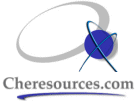|
|
 |
Mike Sondalini: Enterprise Asset Management Best-Practices Powered by Lifetime Reliability Solutions. |
| B Eng (Hons), MBA, CP Eng. In an engineering and management career spanning 25 years he has held project engineering and maintenance management positions at the Swan Brewery and at Coogee Chemicals, a national Australian industrial and mining chemical manufacturer. He is also a qualified mechanical tradesman. Along with authoring numerous maintenance and industrial asset management publications sold on the Internet, he developed the www.feedforward.com.au UPTIME training series for chemical and process plant operators and maintainers. His consultancy 'Lifetime Reliability Solutions' (www.lifetime-reliability.com) specialises in identifying manufacturing and production wastes and losses and solving them using proprietary optimization solutions known as ‘ACE’ (Accuracy Controlled Enterprise), 'DOCTOR' (Design Options and Costs Total Optimization Review) and ‘DAFT Costing’ (Defect and Failure True Costing). He is a past Chairman of the WA Chapter of the Maintenance Engineering Society of Australia. Mike is based in Perth, Western Australia. You can contact Mike by email, phone or fax using the details on his website contact page http://www.lifetime-reliability.com/howtocontact.html. |
| The Instantaneous Cost of Failure |
Abstract The Cost of Failure to a Business When a business operates it expends fixed and variable costs to make a product which it sells for a profit. Figure 1 is graphical representations of a business in operation. The business produces a product that requires an input of costs which it sells to pay for them and make a profit. The business has fixed costs that it must carry regardless of how much it produces. These include the cost of building rent, the manager’s salary, the permanent staff and employees’ wages, insurances, equipment leases, etc. There are variable costs as well, such as fuel, power, hire labour, raw materials to make product, etc. From doing business a profit is made that keeps it trading. In Figure 2 a failure incident occurs at time t1 that stops the operation. A number of things immediately happen to the business. Future profits are lost because no product can be made (though inventory can still be sold until it is gone). The fixed costs continue accumulating but are now wasted because no product is being produced. Some of the variable costs will fall because they are not used, whereas some, like maintenance, will suddenly rise in response to the incident. Other variable costs are retained in the expectation that the equipment will get back into operation quickly. These are also wasted because they are no longer involved in making saleable product. Usually workers are put onto other duties they are not meant to be doing. Losses and wastes continue until the plant is back in operation at time t2. The cost for repair from a severe outage can be many times the profit made in the same time period (the dotted outline in Figure 2). When a failure happens many people suddenly get involved in solving it. Meetings are held, overtime is worked, subcontractors are brought-in, engineers investigate, parts and spares are purchased to get back in operation. Instead of the variable costs being a proportion of production, as intended, they instead rise and take on a life of their own in response to the failure. The losses grow proportionally bigger the longer the repair takes or the greater the consequences of the failure. You can see from the shaded areas in Figure 2 that when a failure happens the cost to the business is lost future profits, plus immediately wasted fixed costs, plus immediately wasted variable costs, plus the added variable costs needed to get the operation back in production. There are many other consequential costs too. When equipment fails operators stop normal duties that make money and start doing duties that cost money. The production supervisors and operators, the maintenance supervisors, planners, purchasers and repairmen start spending time and money addressing the stoppage. If it escalates managers from several departments get involved – production, maintenance, sales, despatch, finance – wanting to know what is being done to fix the stoppage. Meetings are held formally in meeting rooms and impromptu in corridors. Parts are purchased and specialists may be brought in. Customers do not get deliveries and liability clauses may be invoked. Word can spread that the company does not meet its schedules and future business is lost. A rushed work-around is developed that puts people at higher risk of injury. Items are brought, men are moved, materials and equipment are transported in an effort to get production going. Time and money better used on business-building activities is drawn into the ‘black hole of failure’. On and upward the costs build, and on and on people throughout the company waste time because of the failure. The company pays for all of it from its profits, which is then reflected in poor financial performance. The reactive costs and the resulting wastes start immediately upon failure and continue until the last cent is paid on the final invoice. Some consequential costs may continue for years after. These lost and wasted moneys can be considered as the ‘instantaneous cost of failure’ or ‘instantaneous loss’. They are instantaneous because as soon as a failure happens they will need to be spent. There is no alternative but to spend them to get the business back into production. The moneys spent to fix the problem, the lost income from no production, the payment of unproductive labour, the handling of the company-wide disruptions and the loss of future business is money lost forever. However, they would not have had to be spent if the failure had not happened! The money to fix failures and to carry wasted costs is paid by the business from profits. This explains why having many failures, or a few big failures close in time, it can cause a business to become unprofitable. Figure 3 shows the situation of a business suffering repeated failures (the failures do not need to be equipment failures). The losses and wasted costs accumulate in production, the cost of maintenance climbs, the knock-on costs and wasted time across the business rise and profits in the business fall. Each organisation is different and each defect, error and failure it suffers has different consequences. The total cost to the organisation of an incident will be shared amongst the departments and people involved. The proportion of the cost each department ends up carrying depends on the extent of its involvement. The total and true costs incurred by a business from a failure event reverberate and surge throughout the organisation. The 60 consequential costs listed below reflect a good number of them, though there are others specific to each organisation and you will need to identify and record them. · Labour : both direct and indirect § operators § repairers § supervisory § management § engineering § overtime/penalty rates · Product waste § scrap § replacement production § clean-up § reprocessing § lost production § lost spot sales § off-site storage · Services § emergency hire § sub-contractors § travelling § consultants § utility repairs § temporary accommodation · Materials § replacement parts § fabricated parts o materials o welding consumables o workshop hire § shipping § storage o space o handling § disposal § design changes § inventory replenishment § quality control · Equipment § OEM § energy waste § shutdown § handover § start-up § inefficiencies § emergency hire § damaged items · Additional capital § replacement equipment § new insurance spares § buildings and storage · Consequential § penalty payments § lost future sales § legal fees § loss of future contracts § environmental clean-up § death and injury § safety rectification · Administration § Documents and reports § purchase orders § meetings § meeting rooms § stationary § planning, schedule changes § investigations and audits § invoicing and matching The sum totals of the organisation-wide ‘instantaneous costs of failure’ (ICOF) are not usually considered when the cost of a failure incident is determined. This means that most companies do not fully appreciate the huge consequential costs they incur from every failure incident. Few companies would cost the time spent by the accounts clerk in matching invoices to purchase orders raised because of a failure. But the truth is the clerk would not be doing the work if there had been no failure. The cost was incurred only because the failure happened. The same logic applies for all the costs due to a failure – if there had been no failure there would have been no costs and no waste. Prevent failures and you will make a lot more money. The full cost of all ‘instantaneous losses’ from a failure incident can be calculated in a spreadsheet. Simply trace all the departments and people affected by an incident, identify all the expenditures and costs incurred throughout the company, determine the fixed and variable costs wasted, discover the consequential costs, find-out the profit from sales lost and tally them all up. It will astound people when you show them how much money was destroyed by one small equipment failure. It is not important to know how many times a failure incident happens to justify calculating the instantaneous cost of failure. It is only important to ask what would be the cost if it did happen. An extraordinary example was when a 150-mm diameter PVC pipe carrying softened, demineralised water for a major power station failed at a glued joint and began starving the water supply for three boilers supplying steam to six steam turbines. It was only by supplementing the water supply with raw mains water that the power plant remained in operation until the failure was repaired. Had the failure progressed to its disastrous conclusion an entire city of 1.5 million people, and its industry, would have lost power as each turbine progressively stopped from loss of steam. The repair of the pipe was done for several thousand dollars, but the consequence of the failure was in the hundreds of millions of dollars. Had the instantaneous cost of failure been calculated first, far greater precautions would have been put into place to control the hidden risks inherent in the job. Preventing the Consequences of Failure Knowing your total cost of failure is only useful if the failure can be prevented. The best protection against failure is anticipation. Once you have developed a failure costing spreadsheet it becomes a useful tool to apply during the design phase of projects and for preventing downtime incidents during operation. It is also useful for determining the maintainability cost of plant and equipment. Most designers do not calculate the cost of repairing their designs, nor of having to maintain them. This was the case with a hazardous goods storage vessel needing internally inspection to meet statutory compliance. Five years after it was first installed in the production plant a statutory internal inspection was required. The cost just to prepare the vessel for handover was found to be $80,000, which was more than the cost of buying the original vessel. Every five years the organisation had to payed out for maintenance more than the vessel was worth new. Had the ‘instantaneous cost of maintenance’ (ICOM) been calculated by the designers, the dilemma would have been obvious while the design was still on the drawing board and a less costly solution would have been developed. The process of using instantaneous failure costing to optimise the design and select project decisions based on their future consequential operating costs is known as ‘Design and Operation Costs Total Optimisation Review’ (DOCTOR). The process entails taking each separate item of equipment, while still on the drawing board, and assuming it will fail in a variety of possible ways. The costs resulting from each failure are compiled using the consequential cost list above. The costs to apply are the costs of the current practices used in the organisation. The estimated total defect and failure costs are used to review the design and optimise the operating costs. Every item of plant and equipment, down to the individual pipe flange or gearbox shaft, can be put through the DOCTOR process. The costs of failures are used to rate the robustness of the design decision. If the failure costs are unacceptable then a design change is made to reduce the financial consequence, or additional mitigating requirements are included into the operating and maintenance practices to reduce the likelihood of occurrence. DOCTOR applies economics to Reliability Centred Maintenance (RCM) and Failure Mode and Effects cause Analysis (FMECA). It takes the costs of operating failures and brings them into the design stage so the designer can make profitable decisions for the future operation of the business. Figure 4 shows how the DOCTOR method is used during the project design phase. If new decisions are made to the design, or if changed operating practices are introduced, the new model is again put through the DOCTOR and compared with the previous result. In this iterative way the design can be optimised for the best least failure consequences during operation. The moneys lost from a failure are lost in Administration, in Finance, in Operations, in Maintenance, in Service and even in Sales. The impact of a failure reverberates throughout the organisation, sometimes for years. DOCTOR provides a means to find the true costs of failures and identify their full impact on the operation so they can be prevented at the design stage. Conclusion Total defect and failure true costing using ‘Instantaneous Cost of Failure’ shows how vast amounts of money are wasted throughout an organisation when a failure happens. The bigger the failure, or the more often one happens; the more resources and money are lost. The profits that could have been made are gone, wasted, and they can never be recouped. The next time your operation has a failure do an ICOF on it – what did it really cost your company? If someone designs or selects equipment ask them for its ‘instantaneous cost of failure’? Ask them what is its ‘instantaneous cost of maintenance’? What are the cost consequences to the profitability of the business from its failure? It is critical to your company’s profitability that failures are prevented. Failures can be stopped when companies understand the size of the losses and introduce systems, training and behaviours to prevent them. The ‘instantaneous cost of failure’ method shows people the instantaneous losses from failure, and the great profit in doing the right things rightly.
When a failure incident occurs there is a consequential loss of profits and amassing of costs. The cost of failure includes lost profit, the cost of the repair, the fixed and variable operating costs wasted during the downtime and a myriad of consequential costs that reverberate and surge through the business. These are all paid for by the organisation and seen as poor financial performance. The costs of failure cannot be escaped and are counted in millions of dollars of lost profit per year. Total defect and failure true costs are not normally recognised by managers, yet they can send businesses bankrupt. In the instance of a failure all its costs and losses are automatically incurred on the business. These costs can only be prevented by precluding the failure in the first place. This article explains the ‘instantaneous cost of failure’ (ICOF) and introduces a proactive technique, ‘Design and Operation Costs Total Optimisation Review’, that adds economics to RCM and FMEA to help companies recognise and prevent this tremendous waste of money.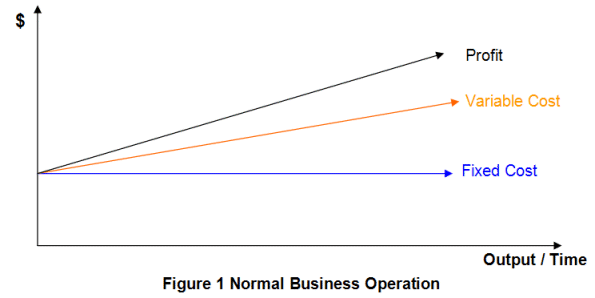
We can take the same analogy of normal business operation down to normal equipment operation. When plant and equipment are running each item has a fixed cost, a variable cost and generates a contribution to the overall business profit. It is reasonable to look at every machine and item of plant in your operation as contributing their share to the total profit of the business – their ‘profit contribution’. When an item of plant cannot be used for production it cannot contribute to profit. If the reason it is not operating is because it has failed, then not only is it not contributing profit, it also imposes added costs on the business.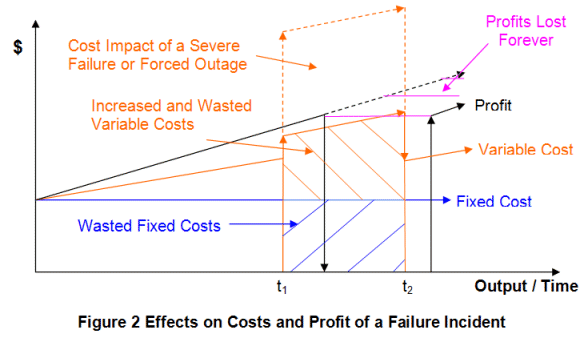
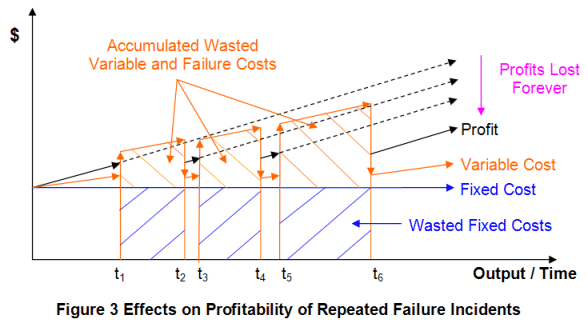
The Total and True Instantaneous Costs of Failure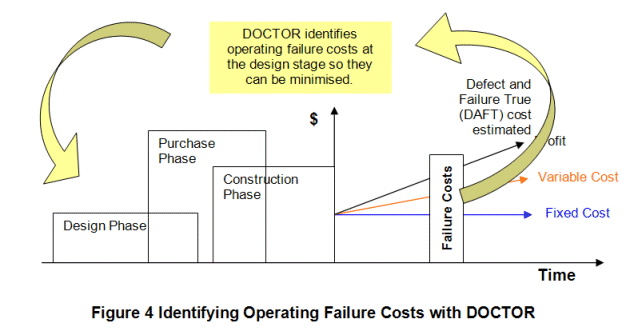
By: Mike Sondalini, Enterprise Asset Management Columnist for Cheresources.com

